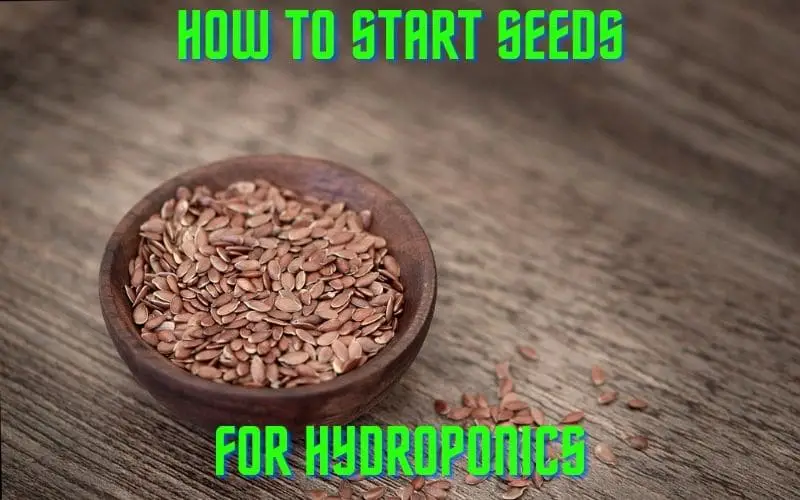How To Start Seeds For Hydroponics: Advice From The Experts!

Introduction
Welcome to our comprehensive exploration of hydroponic soilless agriculture. In this article, we will delve into the fascinating world of starting seeds for hydroponics, offering valuable insights, expert tips, and practical advice for beginners and seasoned enthusiasts alike.
Answer to the Question
Many individuals interested in hydroponics often wonder how to start seeds for hydroponics. Throughout this guide, we will provide a detailed answer to this common inquiry, shedding light on the benefits, types of seeds suitable for hydroponics, the right growing medium, best practices for seed germination, and much more.
Benefits of Starting Seeds for Hydroponics
1. Controlled Environment
Starting seeds for hydroponics offers the significant advantage of a controlled environment. This ensures that factors such as temperature, humidity, and light can be meticulously managed to optimize germination and initial growth.
2. Faster Growth
One of the key benefits of starting seeds for hydroponics is the accelerated growth rate. The controlled environment, coupled with the efficient delivery of nutrients, facilitates faster and healthier plant development compared to traditional soil-based methods.
- Optimal Nutrient Absorption: Hydroponic systems ensure that plants receive the exact amount of nutrients needed for their growth, leading to optimized nutrient absorption.
- Root Development: The absence of soil allows the roots of hydroponically grown plants to focus entirely on expanding and absorbing nutrients, resulting in stronger and more extensive root systems.
- Adaptability: Hydroponic environments enable flexibility in adjusting nutrient levels, pH, and temperature, allowing plants to adapt more effectively to their surroundings and grow at an accelerated pace.
3. Space Efficiency
Starting seeds for hydroponics is a space-efficient gardening method that is particularly well-suited for urban and indoor settings. By utilizing vertical growing systems and compact setups, hydroponic gardeners can maximize their use of limited space, making it possible to grow a variety of plants without requiring a large land area.
Advantages of Space Efficiency in Hydroponics
- Vertical Gardening: Hydroponic systems can be designed to grow plants vertically, taking advantage of unused overhead space to expand growing capacity.
- Compact Designs: The use of compact hydroponic setups allows for efficient use of available space, making it possible to grow more plants within a smaller footprint.
- Optimized Nutrient Uptake: In a well-designed hydroponic system, plants can efficiently absorb nutrients directly from the nutrient solution, reducing wastage and maximizing nutrient uptake per unit of space.
- Increased Yields: The space-efficient nature of hydroponics contributes to higher yields within limited growing areas, providing an effective solution for urban gardening and small-scale farming.
Types of Seeds Suitable for Hydroponics
1. Herbs and Leafy Greens
Herbs and leafy greens are excellent choices for hydroponic seed starting due to their adaptability to soilless growing conditions. They thrive in nutrient-rich hydroponic systems, allowing for robust growth and vibrant flavors. Here are some key points to consider when growing herbs and leafy greens hydroponically:
- Optimal Varieties: Varieties such as basil, cilantro, spinach, arugula, lettuce, and kale are well-suited for hydroponic cultivation, providing an abundant source of fresh, flavorful leaves.
- Hydroponic Environment: Hydroponic systems offer controlled environments that promote efficient nutrient absorption and accelerated growth, resulting in lush and healthy foliage.
- Nutrient Solutions: Customized nutrient solutions tailored to the specific needs of herbs and leafy greens ensure optimal development and flavor profiles, contributing to high-quality harvests.
- Lighting Considerations: Adequate lighting plays a vital role in supporting photosynthesis and overall plant health. LED grow lights are a popular choice for providing the necessary light spectrum for robust growth.
2. Fruiting Plants
Various fruiting plants, including tomatoes, peppers, strawberries, and more, can be effectively started from seeds in hydroponic setups. The controlled environment fosters optimal conditions for germination, growth, and subsequent fruit production.
- Enhanced Nutrient Uptake: Hydroponic systems allow fruiting plants to access nutrients more efficiently, promoting robust growth and flavor development.
- Consistent Water Supply: The controlled water supply in hydroponic environments ensures that fruiting plants receive the optimal amount of hydration, leading to healthier, more abundant yields.
- Space Efficiency: Growing fruiting plants in hydroponic setups maximizes space utilization, making it ideal for urban or indoor gardening where space is limited.
PlantPreferred ConditionsTomatoesWarm temperature, access to sunlight, and proper support for vine growthPeppersConsistent warmth, ample sunlight, and well-aerated growing mediumStrawberriesCool to mild temperature, partial shade, and adequate air circulation
3. Root Vegetables
Hydroponic cultivation of root vegetables opens up new possibilities for growing nutritious and delicious produce. With precise nutrient delivery and controlled growth conditions, root vegetables thrive in hydroponic systems, producing bountiful and high-quality crops. Here are some key points to consider when growing root vegetables hydroponically:
- Choose suitable root vegetables for hydroponic cultivation, such as radishes, carrots, beets, and turnips. These vegetables have demonstrated successful growth and yield in hydroponic setups.
- Selection of the right hydroponic system is crucial for root vegetable cultivation. Deep water culture, nutrient film technique, and wick system are effective methods for cultivating root vegetables.
- Optimize nutrient solutions to meet the specific demands of root vegetables. Tailoring the nutrient composition to support root development and overall plant health is essential for successful hydroponic root vegetable cultivation.
- Monitor pH levels and oxygenation to ensure ideal growing conditions for root vegetables. Maintaining optimal pH and oxygen levels in the nutrient solution promotes robust root growth and nutrient uptake.
- Regularly assess and manage any potential issues related to root health, such as rot or disease. Implementing proactive measures and maintaining cleanliness in the hydroponic system are essential for preventing root-related problems.
Having good energy and a better memory helps big time when organizing and working on your hydropnic garden.
Here is our Top recommendation for improving your memory.
Here is our Top recommendation for increasing your energy.
Choosing the Right Growing Medium
1. Rockwool
Rockwool is a popular choice for hydroponic seed germination due to its excellent water retention and air porosity. Additionally, it promotes healthy root development and can be easily transplanted into larger hydroponic systems.
- Rockwool is made from natural rocks or minerals, which are spun into fibers and then formed into various shapes suitable for hydroponic applications.
- It provides a stable environment for seed germination, ensuring that the seeds receive adequate moisture and oxygen for optimal growth.
- The fibrous structure of rockwool helps in retaining moisture, preventing water-logging and ensuring proper aeration for the roots.
- It is pH neutral, which makes it suitable for a wide range of plant species without causing any imbalance in the nutrient solution.
- Rockwool cubes are commonly used for starting seeds and cuttings, offering a convenient and sterile medium for plant propagation.
2. Coco Coir
Coco coir, also known as coconut coir, is a natural fiber extracted from the husk of coconuts. It serves as an incredibly versatile and environmentally friendly growing medium for hydroponic seed starting, offering several benefits for plant growth and cultivation:
- Excellent Water Retention: Coco coir exhibits superior water retention properties, providing a consistent moisture level ideal for seed germination and early plant growth.
- Superior Aeration: The fibrous structure of coco coir promotes optimal air circulation around the plant roots, ensuring adequate oxygen supply and preventing root rot.
- Rich in Nutrients: Coco coir naturally contains essential nutrients such as potassium, iron, copper, and manganese, which contribute to healthy plant development.
- Environmentally Sustainable: As a byproduct of coconut processing, coco coir is a renewable resource that significantly reduces waste and environmental impact.
- pH Neutral: Coco coir has a neutral pH level, making it suitable for a wide range of plant species and allowing growers to adjust the pH as needed for specific crops.
3. Perlite
Perlite is a versatile and lightweight growing medium that is widely used in hydroponic systems. It consists of volcanic glass that has been heated to a high temperature, causing it to expand. The resulting product is extremely porous, providing excellent aeration for plant roots while retaining moisture effectively. Here are some key points about perlite:
- Seed Germination: Perlite is highly conducive to hydroponic seed germination due to its lightweight and porous nature. It allows seeds to germinate in a supportive environment with optimal moisture and aeration.
- Moisture Retention: Despite its lightweight nature, perlite has the ability to retain moisture, ensuring that the growing medium remains sufficiently hydrated for plant growth.
- Aeration: One of the primary benefits of perlite is its exceptional aeration capabilities. The porous structure of perlite promotes the circulation of air around the roots, which is essential for healthy plant development.
- Neutral pH: Perlite has a neutral pH level, which makes it suitable for a wide range of plant species. It provides a stable foundation for nutrient uptake and supports balanced growth.
- Compatibility: Perlite can be used as a standalone growing medium or mixed with other substrates to create custom blends tailored to specific plant requirements.
Best Practices for Seed Germination
1. Proper Moisture and Oxygen Levels
Maintaining appropriate moisture and oxygen levels is crucial for successful seed germination in hydroponic systems. Ensuring a balance between water and air availability supports healthy germination and initial root development.
- Optimal moisture levels facilitate the movement of nutrients to the seed and help in enzymatic activities during germination.
- Proper oxygen levels are essential to prevent anaerobic conditions, which can lead to root rot and poor growth.
- Using a high-quality growing medium that retains moisture while allowing for proper aeration is vital.
2. Temperature Considerations
Consistent temperature control is essential for successful seed germination in hydroponic setups. Temperature plays a vital role in influencing seed metabolism, enzyme activity, and overall growth rate. Here are some key considerations for managing temperature during the germination process:
- Optimum Temperature Range: Maintaining a consistent temperature range between 65°F and 75°F (18°C and 24°C) is ideal for promoting uniform germination and healthy seedling development.
- Temperature Fluctuations: Sudden and extreme temperature fluctuations can negatively impact germination, leading to erratic seedling growth and reduced crop yield. Implementing insulation and thermal regulation measures can help mitigate these fluctuations.
- Nighttime Cooling: Allowing a slight drop in temperature during the nighttime can mimic natural environmental conditions, which can benefit the germination and growth processes.
- Temperature Monitoring: Utilize digital thermometers and automated control systems to continuously monitor and regulate temperature levels within the germination environment.
3. Light Requirements
Providing adequate light exposure is critical for successful seed germination and early growth in hydroponics. Implementing suitable lighting solutions ensures that seeds receive the necessary light spectrum for optimal development.
When it comes to light requirements for seed germination, there are several key factors to consider:
- Light Intensity: Different seeds have varying light intensity requirements. Some seeds require direct light exposure, while others germinate best in diffused light conditions. Understanding the light intensity needs of specific seeds is crucial for successful germination.
- Light Spectrum: The light spectrum consists of different wavelengths and colors, each of which plays a unique role in plant growth. For example, blue light promotes strong, sturdy stems, while red light stimulates flowering and fruit production. It is essential to provide the appropriate light spectrum for the developmental stage of the seeds and plants.
- Duration of Light Exposure: The duration of light exposure varies depending on the type of seeds and their growth stage. Some seeds require longer periods of light exposure, while others benefit from shorter durations. Understanding the specific light exposure needs of the seeds is essential for promoting healthy growth.
Additionally, the use of artificial lighting in hydroponic systems can significantly impact seed germination and early growth. LEDs, fluorescent lights, and high-intensity discharge (HID) lamps are common lighting options used in hydroponics, each with its own advantages and considerations.
By providing the appropriate light intensity, spectrum, and duration, as well as utilizing suitable artificial lighting, hydroponic growers can ensure optimal conditions for successful seed germination and healthy plant development.
Conclusion
As we conclude this exploration of starting seeds for hydroponics, it’s evident that this practice offers numerous benefits and opportunities for aspiring and experienced hydroponic enthusiasts. By understanding the types of seeds suitable for hydroponics, choosing the right growing medium, and implementing best practices for seed germination, individuals can embark on a rewarding journey of hydroponic plant cultivation.



